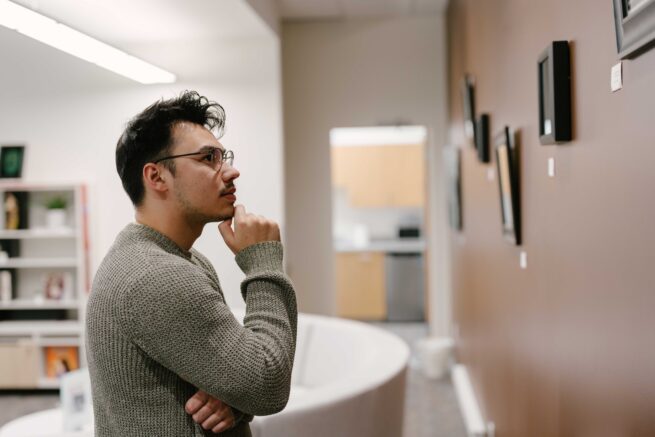June 5, 2024
A unique partnership creates a space for Métis students, and those who want to learn more about Métis culture
Vibrant Métis art, ranging from beadwork to contemporary mixed media paintings, decorates the walls of the Rupertsland Métis Student Centre at NorQuest College.
In November, the centre opened its doors as the first Métis-specific student space within Canada. As a partnership between Rupertsland Institute (RLI) and NorQuest College, it’s open to all post-secondary students.
Métis students from any college or university can access RLI educational and funding support, while its METI-S (Métis Education Training Information Services) Advisors help with all the details. Meanwhile, all students — whether Métis or not — are also welcome to partake in events, learn about Métis culture through various resources, or use the centre as a quiet study space.
“It’s only been in recent years that there have been Indigenous student centres. That’s been a huge step towards reconciliation. But we were hearing from [Métis] students [through Rupertsland] that … they just didn’t see themselves reflected,” says Lisa Savill, Director of Métis Education and Post-Secondary Initiatives at RLI.
Meanwhile, through applications for the Belcourt Brousseau Métis Awards (BBMA) — endowments overseen by Edmonton Community Foundation (ECF) — BBMA founders noticed a lack of Métis representation in post-secondary institutions and the work force.
RLI is an affiliate of the Métis Nation of Alberta with a vision of “a skilled, knowledgeable, and self- reliant Métis Nation,” as described on its website. The Rupertsland Métis Student Centre very much fits into that vision, says Savill.
NorQuest, RLI and the Métis Nation of Alberta entered into an endowment partnership in 2008 and today there is a $1 million endowment in place for scholarships to Métis learners taking many programs through the college. NorQuest is the largest community college in Alberta — with a large number of Métis students. The college offered RLI its own space in a highly visible location. It was a natural fit, according to Savill.
“With over 200 years of resilient history, Métis students are being recognized and celebrated in school settings that have traditionally excluded their voices, states the Rupertsland Institute. “Though Métis students have been creating success in these systems for generations, authentic Métis stories have been dismissed in the narratives of being mixed (only part-Indigenous), or not heard at all, as systems have taken pan-Indigenous approaches to serving Métis, Inuit and First Nations students.”
Historically, Métis people faced displacement and colonization; they faced forced assimilation, institutional denial of culture and discrimination. Art and clothing, often mislabelled as being from artists of other backgrounds, are only now being repatriated. Schools were not safe places for Indigenous children — including Métis — as attested by the many stories in the online RLI Métis Memories of Residential Schools resources.
But since the mid-1700s, Métis people had developed a distinct identity with their own strong and vibrant culture, languages and traditions. It’s a culture backed by strength and resilience. (RLI offers the public a chance to learn about Métis culture and history through Métis Foundational Knowledge Themes, which are free online books and a self-led virtual course.)
It’s the first day after winter break. The centre is quiet but students are busy socializing on the other side of the glass walls before their return to classes. One of those students enters the space for the first time and Savill greets him. After exploring, he mentions it would be great to hear some Métis music in the background.
“Great idea!” Savill says. Fiddle music is an integral aspect of Métis culture, combining Indigenous and often Scottish or French-Canadian rhythms to create a unique sound. And, Savill says, the centre is designed by students so it makes sense to welcome these ideas.
Skyler Wong is the RLI Métis Student Services Centre Coordinator and worked with a group of interns — he originally was one as well — on the centre concept, the interior design, as well as the exterior graphics. Having students front and centre in the concept and inception was key, he says.

Now, Wong helps run the centre by acting as a voice between students, RLI and NorQuest. Advisors help students navigate RLI funding and whatever resources are needed including tutoring support, emergency funding and technology supports.
As a MacEwan University student, Wong received RLI funding that drastically improved his experience on campus. Previously he had been working full time while trying to juggle a part time schedule.
“The funding allowed me to focus on my schooling. I noticed a big increase in my grades,” says Wong. “It took the stress off my parents, as well.”
Now Wong is happy to share those resources with others in a space dedicated to Métis culture.
Many non-Indigenous people who come to the centre, says Wong, are interested in unique elements of Métis culture. “They say they didn’t know any of this stuff, because sometimes it’s not fully taught,” he says.
There is a small room connected to the main space with a table — that features a giant Red River Cart wheel. It’s where students can study or relax. Red River carts were used by Métis people during the mid to late 1800s to carry loads long distances and they are just one aspect of Métis culture that shows the group’s resourcefulness, says Savill.
Beautiful decorative sashes — one hangs across a bookshelf at the centre — were worn by women who used them to carry their babies, hold and mend things. Men also wore the sashes to carry items to keep their hands free for other work tasks.
The loose threads of what looks like decorative tassels were used as threads to mend broken clothing pieces along their travels. Today sashes are generally worn as symbolic pride of the Métis.
Sharing those pieces of culture with those who come to the centre is a point of pride.
“It’s not a big space,” says Donna Bell, who is a member of ECF’s BBMA panel, RLI Vice Chair Board of Governors and Manager of Indigenous Relations and Support at NorQuest’s Student Services department, “But it is significant in the sense that we have a lot of hopes and aspirations for what it looks like.”
One of those hopes is to join forces with the Indigenous Student Centre at NorQuest, says Bell. “That way people can actually see the beauty of working together collaboratively but also see all the nuances and differences between the groups.”
Bell’s work with ECF’s BBMAs has allowed her to help many Métis students receive funding with criteria based upon community involvement and need rather than grades.
“It was important to the founders how these folks are currently contributing to the community, and what are they doing to be active participants,” says Bell. “Because that’s what being a Métis person is about — it’s that reciprocity.”
The founders of the BBMAs were a group of Métis men who wanted to give back. They saw gaps in opportunities for Métis people to receive education and skills development. “They were met with a lot of resistance … but they pushed back and now the BBMAs have a very healthy endowment,” says Bell.
While BBMAs and Rupertsland funding are completely separate entities, students can potentially access both. And they both can make a huge difference in the ability of students to complete their education with less stress.
Bell says she hopes the Rupertsland centre sets a trend for other institutions to support the education of all Indigenous people in a meaningful and tangible way.
“When you have that community that has your back when you don’t think you have the gumption or skill sets to move forward, that’s really important,” she says. “It really is living our ancestors’ dreams of where we would be in the future… that we would exist and actually be who we authentically are as a culture.”
This story comes from the Spring 2024 Edition of Legacy in Action. Read the full issue.